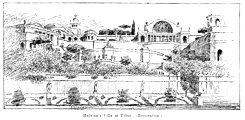Villa
A Roman farm or country-house, of which Roman writers mention two kinds—(
a) the
villa rustica or farm-house, and (
b) the
villa urbana or
pseudo-urbana, a
residence in the country or in the suburbs of a town. When both of these were attached to an
estate, they were generally united in the same range of buildings, but sometimes they were
placed at different parts of the estate. The part of the
villa rustica in
which the produce of the farm was kept was called
villa fructuaria.
(
a) The
villa rustica is described by Varro
(
R. R. i. 11-13), Vitruvius (vi. 9), and Columella (i. 4.5 foll.).
The villa, which must be of size corresponding to that of the farm, is best placed at the
foot of a wooded mountain, in a spot supplied with running water, and not exposed to severe
winds nor to the effluvia of marshes, nor (by being close to a road) to a too frequent influx
of visitors. If there was no running stream, tanks were constructed, one under cover for men,
one in the open air for the beasts. The villa attached to a large farm had two courts (
cohortes, chortes, cortes, Varro, i. 13). At the entrance to the outer court
was the abode of the
vilicus or steward, that he might observe who went
in and out, and over the door was the room of the
procurator (Colum. i.
6). Near this, in as warm a spot as possible, was the kitchen, which, besides being used for
the preparation of food, was the place where the slaves (
familiae)
assembled after the labours of the day, and where they performed certain indoor work.
Vitruvius places near the kitchen the baths and the press (
torcular) for
wine and oil. In the outer court were also the cellars for wine and oil (
cellae
vinariae et oleariae), which were placed on the level ground, and the granaries, which
were in the upper stories of the farm-buildings, and carefully protected from damp, heat, and insects. These store-rooms form the separate
villa
fructuaria.
In both courts were the chambers (
cellae) of the slaves, fronting the
south; but the
ergastulum for those who were kept in chains (
vincti) was underground, being lighted by several high and narrow windows.
The inner court was occupied chiefly by the horses, cattle, and other live-stock, and here
were the stables and stalls (
bubilia, equilia, ovilia). A reservoir of
water was made in the middle of each court—that in the outer court for soaking pulse
and other vegetable produce, and that in the inner, which was supplied with fresh water by a
spring, for the use of the cattle and poultry.
(
b) The
villa urbana or
pseudo-urbana was so called because its interior arrangements corresponded for the
most part to those of a townhouse. (See
Domus.)
Vitruvius (vi. 8) merely states that the description of the latter will apply to the former
also, except that in the town the
atrium is placed close to the door, but
in the country the peristyle comes first, and afterwards the
atrium,
surrounded by paved porticoes, looking upon the
palaestra and
ambulatio.
 |
|
Hadrian's Villa at Tibur. (Restoration.)
|
A striking difference in the general aspect of a country-house from that of a town-house lay
in the fact that the blank walls of the latter were replaced by long colonnades, broken by
towers, apses, and the like.
The chief sources of information on this subject are two letters of Pliny , in one of which
(ii. 17) he describes his Laurentine villa, in the other (v. 6) his Tuscan. The former of
these, however, was not, strictly speaking, a
villa, as it had no estate
or farm-buildings attached to it; the latter was connected with a large estate. There are also
a few allusions in one of Cicero's letters (
Ad Quint. iii. 1) to the remains of
a suburban villa at Pompeii, besides several Roman villas of which ruins exist in England.
See Becker-Göll,
Gallus, iii. pp. 46-63; Overbeck,
Pompeii, pp. 325 foll.; and for the remains of the Roman villas in England,
Neville in the
Archœological Journal, vols. ii., vi., vii., x. For
Pliny 's Laurentine villa, cf. Cowan's edition of Pliny, i.-ii. (with
a plan); Burn's
Rome and the Campagna, pp. 411-415 (with a plan); Aitchison
in
The Builder for Feb. 8th, 1890; and a paper by Dr. H. W. Magoun in the
Proceedings of the American Philological Association for 1895.





